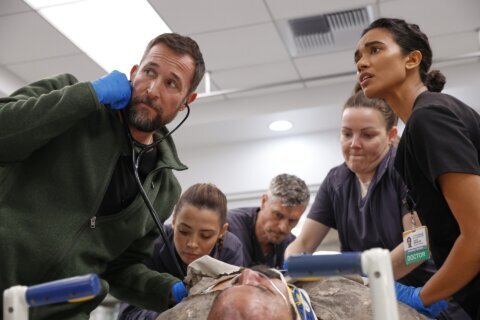His record seven no-hitters and 5,714 strikeouts will likely never be matched in baseball.
All aboard the Ryan Express as the documentary “Facing Nolan” hits streaming Tuesday.
“A lot of people wonder why hasn’t there been a Nolan Ryan movie because the guy is such a legend, he played for so many years, broke so many records and he’s such an enigmatic character,” Director Bradley Jackson told WTOP. “A lot of people, especially Texans, I’m from Texas as well, are very thankful the movie is now out in the public.”
Born in Refugio, Texas in 1947, Ryan grew up playing baseball, football and basketball.
“He wasn’t really thinking, ‘I could be a professional baseball player,'” Jackson said. “One day he got to go see Sandy Koufax pitch and he got a front-row seat. … It was a flashpoint in his life because he saw the way a professional pitched. … It was one of those, ‘I think I could maybe do this.’ Within 10 or 11 years, he’d broken all of Sandy Koufax’s records.”
Ryan broke into the big leagues with the New York Mets from 1966 to 1971, but while he won a World Series ring in 1969, he struggled to control his reputation for wild pitches.
“With the Mets, he was the fifth or sixth best pitcher on that team,” Jackson said. “Tom Seaver was a big mentor of his. Nolan might have a game where he would strike out 12 batters, but he would also walk 12 batters. Then he would have a game where he would hit three batters in two innings. He was kind of like Tim Robbins’ character in ‘Bull Durham.'”
Ryan honed his craft after joining the California Angels from 1972 to 1979 as his pitching coach corrected a habit of bailing off the mound to his left during his follow-through.
“A lightbulb went off once he got to the Angels,” Jackson said. “Nowadays, pitchers have a five-day rotation. He just had a four-day rotation. The idea was if you started a game, you finished it. … Nolan was regularly pitching nine innings. … In ’73, he threw two no-hitters within 60 days of each other. … He pretty much threw four no-hitters in four years.”
During this time, his fastball speed was clocked at over 100 miles per hour.
“In 1974, they measured him at 100.9 [mph],” Jackson said. “That was before they got the speed gun to where it is today where they’re measuring it from the point of release. Back then it was measured 10 feet from the point of release, so the speed would have been 108.1 miles an hour. You don’t hit it! Aroldis Chapman clocked in at 105 a few years ago.”
Ryan moved home to the Houston Astros from 1980 to 1988, including no-hitter No. 5.
“That was the one that broke Koufax’s record,” Jackson said. “[He] kind of thought the no-hit aspect of [his] career was done, but he just had one of those games. … It was a big nationally-televised game against the Dodgers on a Sunday afternoon, a sold-out crowd, he threw No. 5. At that point, everyone was like, ‘What more can this guy do?'”
We found out when he joined the Texas Rangers in 1989.
“His time with the Rangers is really magical,” Jackson said. “He’s 41 years old and I think a lot of people thought it was a PR stunt. … In his first season, he was incredibly dominant. He was incredible. He led the league in strikeouts with like a 2-point-something ERA, he cracks 5,000 [career] strikeouts, and then the next year he throws his sixth no-hitter.”
Yes, he was in his 40s when he threw no-hitters No. 6 and No. 7, the latter at age 44.
“He made such a lasting impression … as this larger-than-life figure, this mythic tall tale, a Paul Bunyon-esque character,” Jackson said. “He really thought he was only going to pitch for one year [for the Rangers] and he ended up pitching five, throws two more no-hitters, gets his 300th win, beats up Robin Ventura on the mound, all of these iconic moments.”
No one will forget Ventura charging the mound, earning a Ryan headlock and uppercuts.
“That’s the third or fourth question everybody asks him,” Jackson said. “You don’t want to make it the first thing you ask him because it might be rude, but you know it’s on the tip of everyone’s tongue. He’s OK to talk about it, but he thinks it’s funny like, ‘I struck out more batters than anybody in history and all you want to talk about is a 30-second fight?'”
When he finally retired in 1993, his place in the MLB record books was astonishing.
“Seven no-hitters, 5,714 strikeouts … [No. 2] Randy Johnson has 4,800 … [Active] leader Justin Verlander [has] 3,100,” Jackson said. “Also, 383 strikeouts in a season. … Six seasons with 300 or more strikeouts, the most one-hitters, two-hitters, three-hitters, most no-hitters taken into the seventh inning, into the eighth inning, into the ninth inning.”
Just how far out in front is Ryan from the next closest pitchers?
“Verlander took a no-hitter into the eighth inning a couple weeks ago,” Jackson said. “They put up a stat that said, ‘Justin Verlander is now tied for second with Randy Johnson for having taken eight no-hitters into the eighth inning — and No. 1 is Nolan Ryan with 23.'”
Ironically, Ryan never won a Cy Young Award, but his peers know his power.
“Getting to interview … Roger Clemens, Pete Rose, Randy Johnson, Craig Biggio, Rod Carew, George Brett, Pudge Rodriguez, Dave Winfield,” Jackson said. “[Cal Ripken Jr.] was so excited to talk about Nolan. Talk about records that will never be broken. Game recognizes game. Ripken recognizes that Nolan’s records are in a league of their own.”
Thus, the film’s title is perfect as batters will never forget “Facing Nolan.”
“Does Nolan Ryan go down as the greatest pitcher of all time?” Jackson said. “I don’t think you can quantify what’s the greatest pitcher of all time. … But if you’re going to make a Top 10 list, you have to include Nolan Ryan. Even if you make a Top 5 list, he’s in the conversation. … He’s one of one. There’s never gonna be anybody like Nolan Ryan.”
Listen to our full conversation here.








